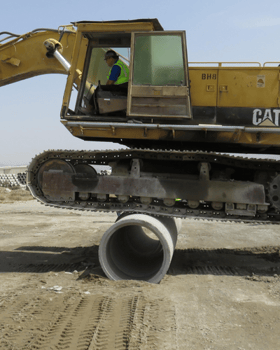STRENGTH
Concrete Pipe: Engineered Strength.
 Crafted from some of the strongest naturally sourced materials on earth, and enhanced through the leveraging of engineering principles, admixtures, reinforced steel, and material science, concrete pipe is unequivocally the strongest stormwater drainage product on the market. With the ability to be tested and proven in the plant before installation, the product’s strength and design load requirements are ensured, guaranteeing reliability for the project. Being a composite structure, reinforced concrete pipe is specially designed to leverage the best features of both concrete and reinforcement. The concrete is designed for the compressive force and the reinforcement for the tensile force. The inherent rigidity of concrete pipes ensures shape retention under pressure, allowing for even load distribution, stable installation, and enduring strength from design to application.
Crafted from some of the strongest naturally sourced materials on earth, and enhanced through the leveraging of engineering principles, admixtures, reinforced steel, and material science, concrete pipe is unequivocally the strongest stormwater drainage product on the market. With the ability to be tested and proven in the plant before installation, the product’s strength and design load requirements are ensured, guaranteeing reliability for the project. Being a composite structure, reinforced concrete pipe is specially designed to leverage the best features of both concrete and reinforcement. The concrete is designed for the compressive force and the reinforcement for the tensile force. The inherent rigidity of concrete pipes ensures shape retention under pressure, allowing for even load distribution, stable installation, and enduring strength from design to application.
Precast concrete pipe is the strongest pipe available. It can be designed and plant-tested to resist any load required. Unlike flexible pipe, it has minimal reliance on installation to support loads; it relies primarily on its inherent brute strength manufactured into the pipe. That adds up to a tremendous difference in the design, the installation and the long-term success of a project.
Compressive strengths for concrete pipe normally range from 4,000 psi to 8,000 psi. It is a function of other factors including, aggregates, cementitious material, the manufacturing process, curing process and mix design. Most concrete design strengths refer to 28 day compressive strengths. It is not uncommon for 28 day tests to substantially exceed the specified design strengths.
Concrete pipe strength is standardized by ASTM C76 and AASHTO M170. Pipe is strength-tested in the plant using D-Load standards. Supporting strength of a pipe is determined under three-edge-bearing test conditions. Expressed in pounds per linear foot per foot of inside diameter or horizontal span, D-load tests the pipe under severe loading conditions where there is no bedding, and no lateral support, under three-point loads.
ASTM C76 (standard for four classes of reinforced concrete pipe)
1. Class I, II, III, IV, V
2. Class III: 1,350 lb/ft/ft
3. Class IV: 2,000 lb/ft/ft
4. Class V: 3,000 lb/ft/ft
Gasketed joints are tested to 13 psi
ASTM C14 (non reinforced concrete pipe)
Class 1, 2, 3
D/Load expressed in lb/linear foot (to compare to reinforced divide by diameter)
Design Loading (used for determining pipe strength for installations underneath traveled roadways)
AASHTO HS20 (Standard for vehicle loads on pipes)
16,000 lbs Axle Load
10” x 20” Tire Footprint
0 – 30% Impact Load
Distributed 1.75H
Wire reinforcement in concrete pipe adds significantly to its inherent strength. Wire reinforcement shaped as cages is a precision-fabricated mesh fabricated by automatic cage welding machines. The cage machines fabricate machine formed bells, are dimensionally stable, and have close engineered tolerances. Reinforced concrete pipes have higher load capacities.
Reinforced concrete pipe is a composite structure and specially designed to use the best features of both concrete and reinforcement. The concrete is designed for the compressive force and the reinforcement for the tensile force. Unless the concrete cracks, the reinforcement is not being used to its design capacity. As more tensile forces are carried by the reinforcement, hairline cracks become visible, but these occur at loads well below the design loading of the reinforced member. Hairline cracks are not an indication of danger, distress, or loss of structural integrity. Concrete pipe is generally designed to carry loads well within the engineered load bearing capacity of a pipeline, and hairline cracks do not occur. If hairline cracks do occur, they tend to seal themselves through a process known as autogenous healing. Autogenous healing is the ability of concrete to repair itself in the presence of moisture. Reinforced concrete pipe, unlike reinforced concrete beams and slabs, are buried where moisture conditions are present for autogenous healing to take place.
Naturally Sourced Materials
Consisting of sand, gravel, or crushed stone, these hard and dense aggregates create the strong foundation of concrete pipe.
Engineered
A concrete pipe’s natural strength is significantly enhanced by leveraging engineering principles. These include he use of reinforcing steel, cement, admixtures, as well as the curing process’s material science (primarily the formation of calcium silicate hydrate (C-S-H) and calcium hydroxide).
Tested
Precast concrete pipe is regularly tested to meet the required and designed loads to help ensure that its strength meets the design requirements of the project.
Rigid
The rigidity of concrete pipes ensures there is no deflection under pressure, guaranteeing they maintain their designed strength while preserving their ability to distribute loads evenly, providing stability and support during installation and use.


